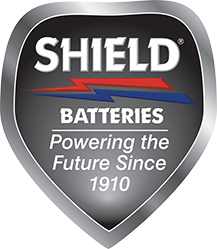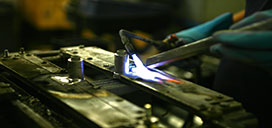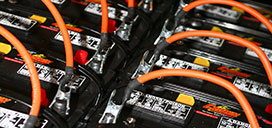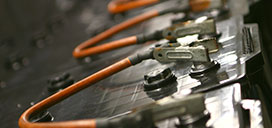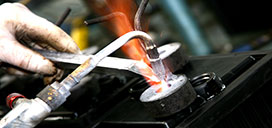How a Battery Works
A storage battery is an electromechanical device. It stores chemical energy which can be released as electrical energy upon demand. When a battery is connected to an external load, such as a starter, the chemical energy is converted into electrical energy and current flows through the circuit. Storage batteries are used in a huge variety of fields, such as automotive – as starter batteries, power for lighting units, leisure, marine, agricultural, UPS, load levelling and much more.
How it operates
When two unlike materials such as the positive and negative plates are immersed in sulphuric acid (electrolyte) a battery is created and voltage is developed. The voltage developed depends upon the types of materials used in the plates and the electrolyte used. In a Lead Acid battery. the voltage developed is approximately 2.1 volts per cell. Electrical energy is produced by the chemical reaction between the different materials and the electrolyte. When the chemical reaction starts, electrical energy flows from the battery as soon as there is a circuit between the positive and negative terminals. The electrical current flows as electrons through the outside circuit and as charged ions between the plates inside the battery.
Discharge Cycle
When a battery is connected to an external load, current flows and it starts to become discharged. The lead dioxide (PbO2) in the positive plate is a compound of lead (Pb) and oxygen (O2). Sulphuric Acid (H2SO4) is a compound of Hydrogen (H2) and the sulphate radical (SO4). As the battery discharges, lead (Pb) in the active material of the positive plate combines with the sulphate (SO4) of the sulphuric acid and forms lead sulphate (PbSO4) in the positive plate. Oxygen (O) in the active material of the positive plate combines with Hydrogen (H2) from the sulphuric acid to form water (H2O) which reduces the concentration of acid in the electrolyte. Concurrently, a similar reaction is occurring at the negative plate. Lead (Pb) from the negative active material combines with sulphate (SO4) from the sulphuric acid to form lead sulphate (PbSO4) in the negative plate.
As the discharge progresses, the sulphuric acid in the electrolyte is being diluted by the water being created thereby reducing the specific gravity of the electrolyte. The specific gravity of the electrolyte can be measured by a hydrometer which provides an accurate and convenient method for determining the state of charge of a battery.
During discharge, the active material of both positive and negative plates is converted to lead sulphate. The plates become more alike and the sulphuric acid becomes weaker – consequently the voltage drops since it depends on the difference between the two plates and the concentration of the acid. Eventually the battery can no longer deliver electricity at the required rate and is said to be discharged.
Recharging
A discharged storage battery can be recharged (pass electrical current through it in the opposite direction of the discharge) and its active materials will be restored to their original composition. Methods of recharging a storage battery include the use of an alternator or a dynamo in an internal combustion engine or an external charging unit (“a battery charger”). As the battery becomes charged, the electricity begins to hydrolyse the water in the electrolyte into its constituent components of hydrogen and oxygen, which is released as gas. This is why a battery gasses when it is charged. The loss of the hydrogen and oxygen through gassing is why it is sometimes necessary to replenish a battery’s electrolyte with distilled water. In a Maintenance Free battery, the gases are not lost and the gases are recombined with the electrolyte.
When fully recharged the battery is again ready to deliver its full power. This discharge / charge cycle can be repeated over and over until eventually plate or separator deterioration or some other factor causes the battery to fail over time.
COMMON SERVICE ISSUES WITH AUTOMOTIVE BATTERIES
OVERCHARGE
Modern car charging systems allow only a small current to flow into the battery when it is fully charged. If there is a fault in the alternator, a much higher current will pass through the battery all the time that the car is running. This current will cause the battery to lose water rapidly, destroying the maintenance free characteristics of the battery, and will also reduce the life of the battery by damaging the positive grids. A dark brown/black colour on the bottoms of the vent-plugs is a strong sign of overcharge. If an alternator (non Start-Stop vehicle) has a voltage above 14.8 Volts at normal temperatures, this is a generally sign that the charging system is faulty. If a common diode fault in the rectifier sees charging voltages of 16.0V at the battery, the alternator should be repaired immediately to prevent any further damage to the battery.
Note: with latest Start-Stop vehicles with Brake Energy Regeneration, higher voltages (15.2V) are used to maximise charging efficiencies and reduce alternator charging periods.
DEEP CYCLING
Modern charging systems keep a battery in a high state-of-charge whist a car is running under most operating conditions. However, the battery will discharge under abnormal conditions or if the car is allowed to stand with a load on, for example, with the headlights on. In addition, on most modern cars when parked there is normally a constant drain on the battery caused by such components as the computer, alarm system, clock etc, and this will cause the battery to become discharged. Depending on the vehicle, this can take weeks or months. Vehicle batteries are designed to accept some cycles of discharge and recharge, but are not designed for applications in which there are constant cycles of charge and discharge (deep cycling). Leisure batteries have been designed for these types of application, and have a special construction to enable them to be deep cycled on a continuing basis. Continual deep cycling of vehicle batteries will cause failure as the positive active material will gradually fall to the bottom of the battery, reducing the ability of the plates to store electricity. A large number of small black/brown particles in the electrolyte are a strong indication that the battery has been deep cycled.
SULPHATION
Sulphation is a normal part of the operation of a battery and occurs whenever a battery is discharged. When the battery is recharged, the sulphation (lead sulphate) is changed back into active material. If a battery is left flat for a period of time, the lead sulphate slowly crystallises into a form that cannot be changed back into active material on charging. Therefore, if this has happened, after charge, the battery will not return fully to give its original performance. If the sulphation is bad enough, the battery will be compromised enough so that a car will not start.
UNDERCHARGE
Undercharge occurs if the battery is not receiving enough charge to return it to a full state-of-charge; this will slowly cause sulphation. This fault can occur if the car is being used only occasionally for short journeys, or for Start-Stop urban motoring. Undercharge will also occur if an alternator or dynamo is not supplying enough charge.
BATTERY REPLACEMENT IS CHANGING
Replacing the battery on a modern vehicle is no longer a straightforward fit-and-forget task.
On vehicles with advanced technology such as Start-Stop, battery replacement can be complex and time consuming.
It is essential the battery on these vehicles is replaced with one of the correct specification. If a vehicle is fitted with an AGM Start-Stop battery then the replacement must also be AGM Start-Stop. The same applies to EFB products.
Most modern vehicles come fitted with a Battery Management System (BMS). This must be reset through the on-board diagnostics (OBD) port to tell the vehicle when the battery has been replaced.
Failure to fit the correct battery or reset the BMS can cause issues such as battery failure and complete loss of Start-Stop functionality.
On many new vehicles the battery is not fitted under the bonnet and locating it can take time. The replacement process can also be extremely time consuming, with some vehicles requiring up to an hour and a half of work.








